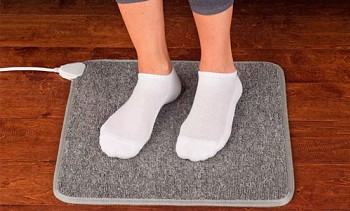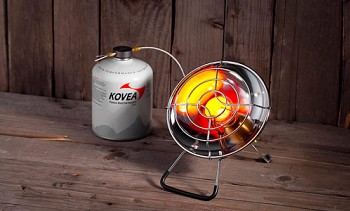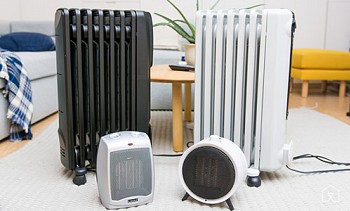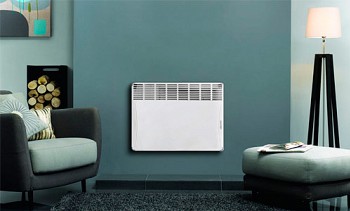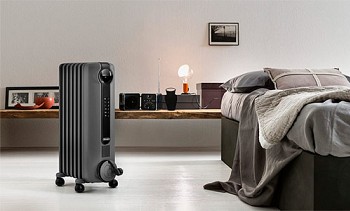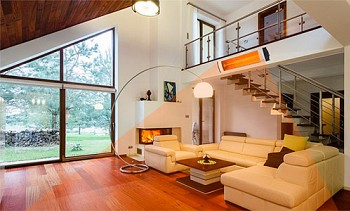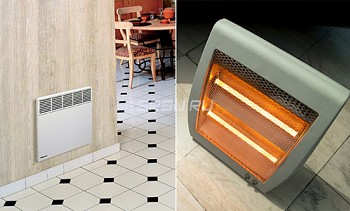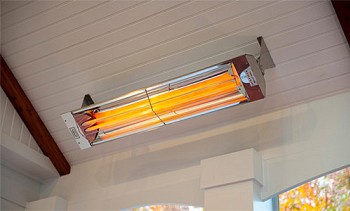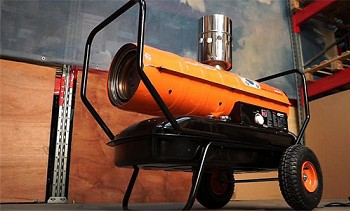The quality of rest in a country house is largely determined by the ability to maintain a comfortable microclimate in the premises. This article will tell you which heater is more economical and better for giving. This will help you make the right choice without resorting to unreasonably high costs for the purchase and ongoing operation of the device.
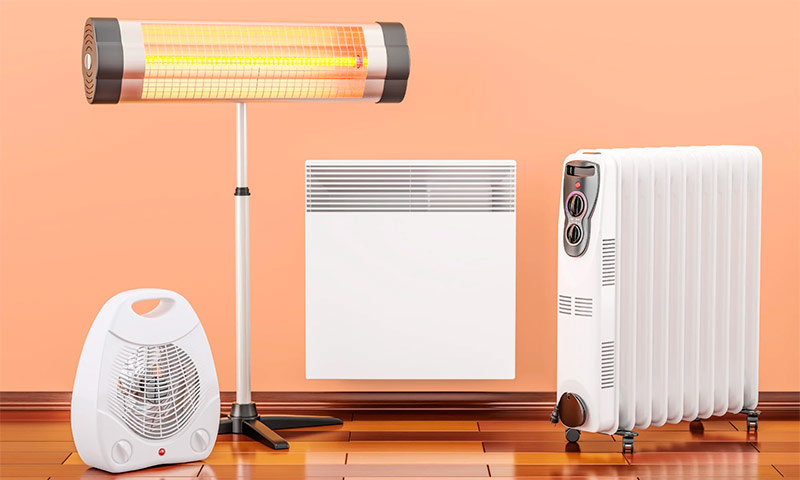
The selection of goods was carried out on the basis of reviews, opinions and ratings of users posted on various resources on the Internet. All information is taken from public sources. We do not cooperate with manufacturers and trademarks and do not call for the purchase of certain products. The article is for informational purposes only.
Which heater is best for giving
Each summer resident knows how important it is to quickly warm up a country house, used for seasonal living or relaxing on weekends. This is especially true in the spring, with the onset of summer frost and with the approach of autumn cold weather. Sometimes it is convenient to use electric heaters for this purpose. It is only necessary to make sure that the heater power meets the characteristics of your mains. It is the state of the electrical network that sometimes causes difficulties with the organization of heating using electrical appliances.
In domestic conditions in the country most often used heaters of the following types:
- convection;
- infrared;
- oil.
A separate class of heating devices called heat guns is not considered in this article. They emit increased noise and are not intended for use in a domestic environment. Weak fan heaters are devoid of such shortcomings, but have low power, which does not allow to warm up the premises of a country house effectively.
Convection heaters

Electric appliances of this type have a heating element that heats up to a high temperature, which gives off heat to air flows rising along its walls. During the operation of such a device, a sufficiently intense circulation of air masses arises, which leads to a rapid heating of the room.
The principle of operation of a convector heater


The required heater power is selected based on a simple formula: 1 kW for every 10 m2 of the area of the heated room. The lineup of any well-known brand is usually represented by products of various capacities. Adapt the operation of the heater to specific conditions allows the system of settings and regulation.
Manufacturers offer convection heaters of various shapes and sizes. There are options for floor or wall installation. Modern models are equipped with automation tools that can maintain temperature accurate to a degree, provide a comfortable or economical mode of operation, turn on and off in accordance with a given program at a time appointed by the user.
The safety of convector heaters is ensured by a special casing design that protects the electrical equipment from water ingress, protection against overheating and blocking when capsizing.

+ Advantages of convector heaters
- High speed of heating the room.
- Profitability of operation.
- Fire safety.
- No noise and noxious substances.
- Easy installation and intuitive controls.
- The presence of several modes of operation provided for a number of models to accurately maintain a given air temperature.
- The possibility of not only stationary installation, but also moving around the house.
- No need for maintenance, just periodically wipe the dust from the outer surface of the housing.

- Cons of convector heaters
- Increased requirements for the reliability of electrical wiring.
- High tariffs for electricity consumption.
Features of application for a summer residence. When choosing convectors for a country house, it must be borne in mind that one convector is designed to heat one room. If you need to produce heating in several rooms, you will have to purchase a convector for each. For ease of use, convectors located in different rooms can be combined into one system with one control unit. Thus, you can quickly and accurately control the temperature throughout the house.
Infrared heaters

This type of heater is based on the generation of heat rays. They are absolutely safe and able to heat surfaces at some distance from the source. Similarly, the sun gives us its energy. In the coverage area of such a heater, a person feels as comfortable as possible.
The principle of exposure to an infrared heater

Infrared heaters can be mounted to walls and ceilings. They are most effective when it is required to heat not the entire room, but only a certain area of it. Usually they have an increased class of protection against moisture, which allows you to use them even in open areas, in showers and bathrooms. Most models of this type are designed for stationary installation. For the convenience of users, manufacturers often provide rotary devices that allow shifting the heating area.

+ Pros of infrared heaters
- The long service life provided with high reliability of a design and the used materials.
- Fire safety.
- Possibility of operation outside buildings and in rooms with high humidity.
- Convenience of connection and settings.
- The possibility of centralized regulation of several devices.
- A full replacement of a warm floor.
- Maximum efficiency in spot and zone heating.

- Cons of infrared heaters
- Only a fixed installation is provided.
- There are restrictions on the minimum and maximum ceiling heights.
- Low degree of intelligence management.
- There is a risk of overheating during prolonged use.
Features of application for a summer residence. All infrared heaters differ in areas of infrared radiation.
According to human exposure, the following areas of infrared radiation (IR-Infrared Radiation) are distinguished:
- Near (IR-A). Wavelength from 0.76 to 1.5 microns, deeply penetrate under the skin (up to 4 cm);
- Medium (IR-B). Wavelength from 1.5 to 3 microns, average penetration;
- Far (IR-C). Wavelengths from 3 to 8 microns, do not pass further than the surface.
Best of all, the human body perceives long-wave radiation - (IR-C). But short-wave radiation (IR-A) with prolonged and intense exposure to the human body can lead to negative consequences in the form of a headache or heat stroke. Since for a summer residence you most likely need appliances that you will use for a long time, it is necessary to choose infrared heaters with long-wave radiation (IR-C).
You can understand what kind of heater is in front of you based on the type of heating element. The more waves of small length in the spectrum, the higher the temperature and the brighter the glow of the heating element. Conversely, the more long waves in the spectrum, the lower the temperature, and the glow may be absent altogether.
- Anodized aluminum panel heating elements - contain 98% of the IR-C spectrum.
- Quartz heating elements - contain 84% of the IR-C spectrum and 15% of the IR-B spectrum of 15%.
- Carbon heating elements - contain 70% of the IR-C spectrum and 15% of the IR-B spectrum 29%.
- Halogen heating elements - contain 35% of the IR-A spectrum.
Thus, the most optimal option for human exposure are infrared heaters of the panel type, and it is advisable to use these devices as heating the premises of a country house. Panel IR heaters can have wall or ceiling mounting. As in the case of convectors, for each room you will need your own heater. In this case, each heater should be located in such a place as to maximally scatter the infrared rays in the room.
Oil heaters

Such devices are an oil-filled metal case with embossed walls, inside which a heater is mounted. When you turn it on, the oil is first heated, which then gives off heat to the surrounding air. This design eliminates the contact of external objects and a person with hot surfaces.
The oil heater remains warm for a while after turning it off. This is not always convenient, since it leads to unreasonably high energy consumption. Heaters of this type usually have considerable weight, but are mounted on rollers, which facilitates their movement around the house.

+ Pluses of oil heaters
- Duration of operation.
- Mobility.
- Simple and reliable control.
- Affordable cost.

- Cons of oil heaters
- Increased room warm-up time in comparison with other types of electrical appliances of similar power.
- Cracking during work.
- There is no intelligent control.
- Inability to combine several devices into a single system.
- Large mass and excess dimensions.
- Negative effect on indoor air humidity.
- The need for preheating at first start-up.
- Excessive waste of energy, because the device continues to give off heat even after it is turned off.
Features of application for a summer residence. Oil heaters are purchased for summer residence, when the priority factor is the low cost of purchase and use them as a temporary option for heating with electricity. During operation, they are inferior in efficiency and ease of use. Otherwise, we recommend paying attention to convectors or infrared heaters.
The best heaters for summer cottages
When choosing a heater, the operating conditions, technical requirements and aesthetic preferences of the buyer must be taken into account. Specialized stores will offer you a wide range of such devices, but it is better to opt for proven models.
The best convection heaters for summer cottages
NeoClima Comforte T2.0 EVNA FROM2
This convector is suitable for quick heating of rooms up to 20 m2 and maintaining comfortable conditions in them. It can be mounted on the wall or mounted on the floor. For this, a set of brackets and legs is included in the package. The model is equipped with automatic overheat protection and a mechanical mode switch.
Main characteristics:
- power - 2 kW;
- dimensions - 450x740x110 mm;
- weight - 5.3 kg;
- degree of protection - IP21.


+ Pros NeoClima Comforte T2.0 EVNA C2
- Compact size.
- Laconic appearance that is suitable for any room.
- Convenience of fastening.
- The presence of a handle for carrying.
- Quick exit to an operating mode.
- 5 year warranty.
- Affordable price.

- Cons NeoClima Comforte T2.0 EVNA C2
- Only two operating modes without the possibility of precise temperature control.
- A little buzz.
- When the lock is activated, it quickly cools and does not turn on for several minutes.
- After a long interruption in operation, the smell of soot is felt.
Output. This model is simple and convenient to use. It can be easily installed by anyone who knows how to handle a drill and screwdriver. It takes up a minimum of space and copes well with heating large enough rooms. The costs of acquiring and operating such a heater are available to any family.
Electrolux Ech/B-1500E
This convector is made of aluminum alloy and heat-resistant ceramic.It is usually used as additional heating or the main source of heat in rooms up to 15 sq.m. Shockproof coating reliably protects the housing from external mechanical stress. The model is designed for installation on the floor or hanging. Support rollers facilitate the movement of the device. There are sensors for protection against overheating and falling.
Main characteristics:
- power - 1.5 kW;
- dimensions - 418x640x111 mm;
- weight - 6.41 kg;
- degree of protection - IP24.


+ Pros of Electrolux ECH / B-1500E
- The small sizes.
- Modern design that fits any interior.
- Mobility.
- Lack of noise and smell during the work.
- Electronic control with the accuracy of maintaining the temperature to 0.1 degrees.
- The high level of moisture protection allows the appliance to be used in showers and bathrooms.
- Acceptable price.

- Cons Electrolux ECH / B-1500E
- The power of the device does not allow heating large rooms.
- Over time, a high-frequency squeak may appear.
- The cost of the heater is slightly higher than that of domestic models with similar characteristics.
Output. This heater copes with heating small rooms and maintaining a comfortable temperature in larger rooms. It can be easily moved inside the house. It does not need a lot of storage space. It will appeal to those for whom it is important not only work efficiency, but also the attractive appearance of the product. This household appliance is reliable and designed for long-term operation.
Noirot CNX-4 1500
The convector of this brand in the basic configuration is designed for wall installation, but floor-mounted operation is possible with the additional purchase of support legs. It is usually used in rooms up to 20 sq.m. It works silently and quickly heats the room, even on the first visit to the cottage after winter. The electronic thermostat maintains the air temperature at a predetermined level. There is a power indicator and emergency overheat protection.
Main characteristics:
- power - 1.5 kW;
- dimensions - 440x580x80 mm;
- weight - 4.4 kg;
- degree of protection - IP24.


+ Pros of Noirot CNX-4 1500
- High quality workmanship, confirmed by a lifetime warranty.
- Fairly high power.
- Small size and light weight.
- Beautiful design.
- Mobility.
- Low noise and no smell.
- Accurate and reliable thermostat operation.
- High level of moisture protection.

- Cons Noirot CNX-4 1500
- The need for a separate purchase of supports for floor installation.
- Relatively high cost.
Output. The minimum flaws with obvious advantages make the Noirot CNX-4 1500 one of the best models in its class. The price of such a device pays off due to trouble-free operation, ease of operation, long life and minimal maintenance.
Ballu Bec/EVM - 1500
This convector is equipped not only with an effective heating element with a high surface area, but also with an air ionizer, which helps maintain a favorable microclimate in the house. The mechanical thermostat reliably maintains the set temperature conditions. The model is attached to the wall or mounted on the floor.
Main characteristics:
- power - 1.5 kW;
- dimensions - 413x630x111 mm;
- weight - 4.44 kg;
- degree of protection - IP24.


+ Pros of Ballu BEC / EVM - 1500
- Excellent value for money.
- Reliable and effective heating element with a resource of 25 years.
- Compactness.
- Strict design.
- The presence of rollers to move.
- Built-in air ionizer.
- Very fast heating.
- High level of moisture protection.

- Cons Ballu BEC / EVM - 1500
- Weak plastic supports may be damaged by pressure or impact.
- The thermostat is not designed to accurately maintain the temperature and works with clicks when switching from heating to cooling mode and vice versa.
Output. High quality at a reasonable price, combined with exceptional reliability of the product will appeal to the widest circle of owners of suburban real estate. It is especially useful for families with increased requirements to ensure a healthy microclimate in a country house.
The best infrared heaters for summer cottages
Hyundai HC2 1.5 kW H-HC2-15-U1697
This heater has an elongated shape. It is attached to the ceiling and is designed to heat local areas located directly below it. It has a modern design that allows you to install the device in any room. During its operation, convective air flows do not occur, which helps to reduce dust content. The heating element is a radiating panel operating in the infrared range.
Main characteristics:
- power - 1.5 kW;
- dimensions - 1620x125x45 mm;
- weight - 3.5 kg;
- degree of protection - IP20.


+ Pros of Hyundai HC2 1.5 kW H-HC2-15-U1697
- Fast heating of the heated zone.
- Absolute safety, since there is no risk of burns or damage to the appliance, which is typical for floor heaters.
- Compactness.
- A thoughtful installation method.
- Attractive appearance.
- Long service life.
- No maintenance required.
- Low price.

- Cons Hyundai HC2 1.5 kW H-HC2-15-U1697
- Stationary operation only.
- There is a slight crackle in the silence.
Output. This model is ideal for heating small rooms or local areas where maintaining a comfortable temperature is especially important. It is often installed over recreation areas or a place of long classes.
Ballu Bih-AP4-0.6
A heater of this brand is installed on the ceiling or attached to the wall. It is able to heat an area of up to 12 square meters. He is not afraid of high humidity. Optimum installation height from 2.4 to 3.5 m.
Main characteristics:
- power - 0.6 kW;
- dimensions - 875x150x55 mm;
- weight - 2.0 kg.


+ Pros of Ballu BIH-AP4-0.6
- Dust and moisture proof housing.
- Convenient fastening with a possibility of correction of the direction of a heat stream.
- Compactness.
- When installing under the ceiling, the useful volume of the room is not cluttered.
- Attractive appearance.
- Long service life.
- There is no smell.
- Oxygen does not burn out.
- No maintenance required.
- Stylish appearance.
- Low cost.

- Cons Ballu BIH-AP4-0.6
- Stationary operation only.
- Lack of a temperature regulator.
- Low power, suitable for small rooms.
Output. This model is well suited for heating local areas. The ability to rotate the housing facilitates adjustment and allows you to change the direction of radiation. To heat spacious rooms, you will need a set of several such devices.
Timberk Tch Ab8 2000
This infrared heater is designed for ceiling installation. It has the shape of an elongated rectangle and a stylish design. With its help it warms up to 20 m2 the area of the room. Heating occurs almost immediately after switching on. Maximum installation height 2.5 m.
Main characteristics:
- power - 2.0 kW;
- dimensions - 1620x273x43 mm;
- weight - 9.6 kg.


+ Pros Timberk TCH AB8 2000
- Reliability and high build quality.
- Beautiful dark body.
- Simple mount.
- When installed under the ceiling does not interfere with the movements of residents.
- Silent work.
- Quick warm-up of the room.
- Long service life.
- No smell of burning dust.
- Minimal care.
- Affordable cost.

- Cons Timberk TCH AB8 2000
- It stands out against a light background.
- When operating at full power, it consumes a lot of electricity.
- In rooms with high ceilings, work efficiency is reduced.
Output. This model copes with the role of not only additional, but also the main source of heating. In the latter case, one must be prepared for increased electricity costs. The heater is designed for a long service life and works flawlessly.

